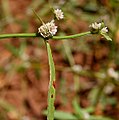Alternanthera sessilis
| Alternanthera sessilis | |
|---|---|

| |
| Scientific classification | |
| Kingdom: | |
| (unranked): | |
| (unranked): | |
| (unranked): | |
| Order: | |
| Family: | |
| Subfamily: | |
| Genus: | |
| Species: | A. sessilis
|
| Binomial name | |
| Alternanthera sessilis | |
| Synonyms | |
| |
Alternanthera sessilis is an aquatic plant known by several common names, including ponnanganni (in Tamil), ponnaganti aaku (in Telugu), Mukunuwenna (in Sinhala), sessile joyweed and dwarf copperleaf. It is used as a vegetable specially in Sri Lanka and some Asian countries.
Distribution
The plant occurs throughout the tropical and subtropical regions of the Old World. It has been introduced to the southern United States, and its origins in Central and South America are uncertain.
Botanical features
This is a perennial herb with prostrate stems, rarely ascending, often rooting at the nodes. Leaves obovate to broadly elliptic, occasionally linear-lanceolate, 1–15 cm long, 0.3–3 cm wide, glabrous to sparsely villous, petioles 1–5 mm long. Flowers in sessile spikes, bract and bracteoles shiny white, 0.7-1.5 mm long, glabrous; sepals equal, 2.5–3 mm long, outer ones 1-nerved or indistinctly 3-nerved toward base; stamens 5, 2 sterile. In the wild it flowers from December until March.
Similarity
Aerva lanata is often mistaken for Alternanthera sessilis, which is also of the Amarantheceae family, and looks similar. On careful observation you will notice that flowers of Alternanthera sessilis are situated over the stem and their shape is round. As its flowers look like the eyes of a fish, Alternanthera sessilis is called Matsyakshi, fisheyed. Other Indian names of this plant are Koypa in Marathi, Honganne ಹೊನಗೊನ್ನೆ ಸೊಪ್ಪು in Kannada, Ponnaganti koora పొన్నగంటి కూర in Telugu, Ponnanganni Keerai பொன்னாங்கண்ணி கீரை in Tamil peānnaṅṅāṇi പൊന്നങ്ങാണി in Malayalam. The plant is known as "Mukunuwenna" මුකුණුවැන්න in Sinhala. The plants are shredded finely and stir fried with grated coconut and spices to make what is known as "Mukunuwenna mellum".
Uses
The plant grows wild, but is also cultivated for food, herbal medicines, as an ornamental plant (red variety, as a hedging plant), in the aquarium trade (though it only grows submersed for short periods), and as poultry feed.
In certain regions of South East Asia, the leaves and young shoots are consumed as vegetables.[2] in Karnataka, Andhra Pradesh and Tamil Nadu, the leaves, flowers and tender stems are consumed as vegetables.
As a herbal medicine, the plant has diuretic, cooling, tonic and laxative properties. It has been used for the treatment of dysuria and haemmorrhoids.[3] The plant is also believed to be beneficial for the eyes, and is used as an ingredient in the making of medicinal hair oils and Kajal (kohl).
This species is classified as a weed in parts of the southern States of the USA. It is usually (but not always especially in areas of high humidity where it can even be a garden weed) found in wet or damp spots.
Gallery
References
- ^ Template:IUCN2014.1
- ^ Grubben, G.J.H. & Denton, O.A. (2004) Plant Resources of Tropical Africa 2. Vegetables. PROTA Foundation, Wageningen; Backhuys, Leiden; CTA, Wageningen.
- ^ Tanaka, Yoshitaka; Van Ke, Nguyen (2007). Edible Wild Plants of Vietnam: The Bountiful Garden. Thailand: Orchid Press. p. 21. ISBN 9745240893.




